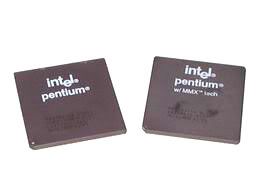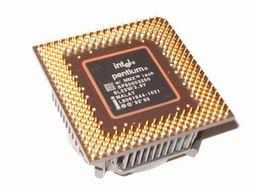The Pentium and Pentium MMX....
Obsoletus Instrumentum - The Pentium and Pentium MMX On March 22, 1993, Intel released its fifth generation processor and successor to its highly succesful 486 CPU - the Pentium processor.
On March 22, 1993, Intel released its fifth generation processor and successor to its highly succesful 486 CPU - the Pentium processor.
Even though x86 processors at the time still lagged behind their RISC counterparts when it came to raw performance, the Pentium still represented a revolution as far as x86 processors were concerned. Intel borrowed a page from the RISC movement and designed a mainstream x86 processor with superscalar architecture - in a nutshell, the ability of a CPU to process more than one instruction per clock cycle. Today, all processors, from the lowliest Semprons and Celerons, to the top tier Pentium 4s and Athlon 64s, all possess superscalar architecture. And the original Pentium was the first x86 processor to have this feature.
The Pentium processor also possessed a 64-bit wide data path (internally it still had 32-bit registers), 16KB of Level 1 (L1) cache, and a fully pipelined floating point unit. Unfortunately, the first Pentiums were plagued by a recurring error in their floating point units which made them imprecise in performing complex division problems. The bug (which came to be known as FDIV bug) was fixed in subsequent steppings of the processor.
Because of the complexity of its design, it had a transistor count significantly higher than any of its predecessors - 3.1-3.3 million transistors, compared to the 1.2-1.6 million transistors of the 486. The Pentium was fabricated using various process technologies, from 0.8µ, 0.6µ, and finally on a 0.35µ process design. Clock speeds ranged from 60 and 66 MHz to 200 MHz, and connected to the motherboard via the Socket 7 interface with a frontside bus (FSB) that ran at either 50, 60, or 66 MHz.

100 MHz Pentium and 166 MHz Pentium MMX. Blazingly fast performers during their time. Excrutiatingly slow by today's standards.
 On January 8, 1997, a newer version of the Pentium was released. This version was known as the Pentium Processor with MMX Technology or simply the Pentium MMX. It was architecturally similar to the original Pentium (now referred to as the Pentium Classic) but featured an additional 57 instructions for improving performance on multimedia tasks such as media encoding or decoding. Its L1 cache was also doubled in size to 32KB. As a result of these enhancements, transistor count increased by 1.2 million for a total of 4.5 million transistors. Desktop versions of the Pentium MMX ran at up to 233 MHz.
On January 8, 1997, a newer version of the Pentium was released. This version was known as the Pentium Processor with MMX Technology or simply the Pentium MMX. It was architecturally similar to the original Pentium (now referred to as the Pentium Classic) but featured an additional 57 instructions for improving performance on multimedia tasks such as media encoding or decoding. Its L1 cache was also doubled in size to 32KB. As a result of these enhancements, transistor count increased by 1.2 million for a total of 4.5 million transistors. Desktop versions of the Pentium MMX ran at up to 233 MHz.

200 MHz Pentium MMX viewed from underneath. Heat sink is glued permanently to the top of the processor. This was the last Intel processor I ever bought, before I started using AMD processors exclusively for my personal systems.
Nowadays, when processors can reach clock speeds in excess of 3 GHz, the original Pentium family seems highly antiquated in comparison. However, they were indeed the fastest processors during their time, and they represent nothing less than a milestone in x86 processor development. In fact, we still reap the benefits of those enhancements up to the present day. The Pentium name lives on in Intel's 7th generation processor, the Pentium 4.
Earlier in this series:
The Sound Blaster 16....
Comments